Written by: Réka Pétercsák, SPC, PSM I, PSPO I
What is SAFe® and how does the use of SAFe affect the effectiveness of the organisation?
SAFe® is a robust organisational framework that supports the agile operations of an entire organisation. It can be built into an "operating system" within an organisation that helps to maintain a secure agile-based way of working in a changing market environment.
The aim of this series of articles is to introduce you to some of the broad, important elements of the SAFe framework to help you understand the framework. This article is based on the new SAFe 6.0 release.
Why choose SAFe®?
The promise of the SAFe® system is to make the creation of complex products and services, even those requiring the collaboration of several teams, transparent, predictable and continuous by introducing rules, events and roles. It makes use of well-established frameworks and approaches that are already well-known parts of agile organisational operations, such as Lean, Scrum, Kanban or DevOps.
The growing popularity of SAFe®
It is important to highlight that SAFe is one of the existing scaled agile frameworks, it is not the only solution for organisations, but it stands out for its popularity. For example, the 2022 State of Agile survey highlights that the percentage of people working in SAFe has increased from 37% to 53% in the last eight years, second only to Scrum of Scrums/ScrumatScale around scaled frameworks, used by 28% of respondents. The advantage (and sometimes disadvantage) of SAFe is that the framework is very detailed, taking into account all dimensions of complex organisational operations, whether the company has 50 or thousands of employees.
Why do we need SAFe®?
SAFe makes an interesting point: With the rise of software, many companies are becoming at least partly software companies, regardless of industry, such as banks, insurance companies, car manufacturers and others, If we know that motivated, cross-functional teams working in more organic systems with a focus on the customer can quickly create value and adapt flexibly, then is the era of hierarchical companies finally over?
Shall we start all over again?
SAFe, drawing on John Kotter's Accelerate, stresses that we should not throw out what we know and start from scratch, but suggests introducing a so-called second operating system. The hierarchical system that drives the revenue model, provides efficiency and stability, keeps the lights on, sells and maintains products and services should remain, but a second system should be created to bring agility and adaptive capacity back into organisations.
This second operating system is focused on bringing new solutions to customers, flexibility to address emerging issues, agility, adaptability and Value Stream. According to Kotter, the solution can therefore be envisioned as a dual operating system that gives organisations back their ability to innovate by introducing networking, while relying on the stability of a hierarchical system.
Break down your SAFe® complex system into elements
Three topics can help you get started when you take the first steps towards getting to know the framework: the concept of business agility, the key competencies of SAFe and a high-level understanding of SAFe versions.
Business agility
Firstly, the concept of business agility, in response to the above, refers to the complex ability of an organisation to create innovative business solutions in response to market changes. SAFe proposes to do this by operating the Business Agility Value Stream (BAVS) and by mastering the seven key competencies at a high level. The Business Agility Value Stream is, in simple terms, a process that focuses on shortening the time from business opportunity detection to value delivery in several phases. You can find out more about each phase here. To properly execute the phases of the Business Agility value stream requires a change of mindset, learning, lean and agile tools.
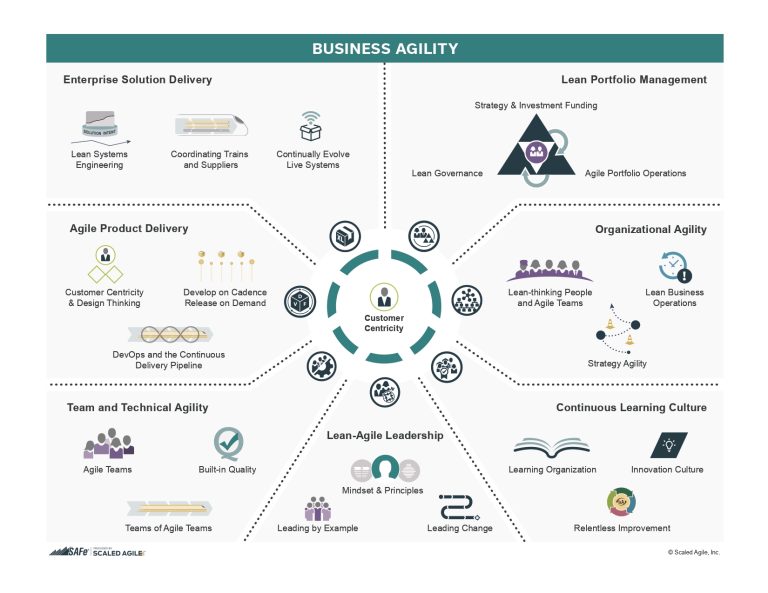
Key competences of SAFe
The second topic, the seven SAFs, are key competences, which, if operated at a high level, can create organisational agility and responsiveness. Each key competency is valuable in its own right, but for organisational agility, companies need top-level mastery of all competency areas. At the heart of the system is a customer-centric approach, which underpins the seven competency areas, each of which has three sub-areas. The 21 key competences are the primary framework for understanding and implementing SAFe. For beginners, we recommend first learning about the following four of the seven competences.
#1 Team and Technical Agility competency - Team and Technical Agility
It is a set of critical skills and Lean-Agile principles and practices that are used by high-performing Agile teams and teams of Agile teams to create quality solutions for their customers. The competencies are grouped around three themes that need to be understood and operated at a high level:
- Agile teams
What does it mean? High-performing, cross-functional teams working effectively along agile principles and good practices.
- Team of Agile Teams
What does it mean? Agile teams work within the framework of an Agile Release Train (ART), a collaboration between teams with a shared vision, direction and responsibility for delivering solutions.
- Built-in Quality
What does it mean? All agile teams work according to defined agile practices, which ensure the creation of high quality solutions. SAFe calls this Quality Practices (link: https://scaledagileframework.com/built-in-quality/)
#2 Agile Product Delivery competency - Agile product delivery
Agile product development/product delivery defines, develops and brings to market products and services of value to the customer in a customer-focused approach. The competencies are grouped around three themes that need to be understood and operated at a high level:
- Customer Centricity and Design Thinking
What does it mean? Customer-centricity puts the customer at the centre and uses design thinking to ensure that solutions are truly customer-driven, feasible and sustainable.
- Develop on Cadence; Release on Demand
What does it mean? Development in phases and demand-driven, i.e. market release based on customer needs, helps to manage the changes that naturally occur as part of product development, and by treating value delivery separately from development, we can ensure that the customer gets what they want, when they need it.
- DevOps and the Continuous Delivery Pipeline
What does it mean? DevOps operations and working in a 'Continuous Value Delivery System', or Continuous Delivery Pipeline, approach is the basis for organisations to deliver value, in whole or in part, whenever it is needed.
#3 Lean Portfolio Management
Responsible for the alignment of the LPM competency strategy and implementation, using Lean and systems thinking to design and implement the strategy and investments, agile portfolio management and governance model. The competencies are grouped around three themes that need to be understood and operated at a high level:
- Strategy and Investment Funding
What does it mean? The entire portfolio is aligned and resourced to create and maintain the solutions needed to achieve business goals. This requires the collaboration of Business Owners, portfolio stakeholders and Enterprise Architects.
- Lean governance
What does it mean? We include cost management, auditing, compliance management, cost forecasting, measurement. The collaboration of the Value Management Office/Lean-Agile Center of Excellence (VMO/LACE), Business Owners, Enterprise Architects is the basis for this competence.
- Agile Portfolio Operations
What does it mean? Coordinate and support the ART operations, creating high quality operations. This requires the cooperation of the VMO, LACE, the community of practice for RTEs (Release Train Engineers) and the Scrum Masters/Team Coaches.
#4 Lean-Agile Leadership - Lean-Agile Leadership Approach and Practice
Competency involves how Lean-agile leaders model and sustain organisational change and high quality performance by empowering their employees, supporting them to achieve their full potential. The competencies are grouped around three themes that need to be understood and operated at a high level:
- Mindset and Principles
What does it mean? They model the behaviour to be followed in the organisation by incorporating Lean agile practices into their daily practice, in their beliefs, decisions, responses and actions.
- Leading by Example
What does it mean? Leaders earn, not demand, empowerment by setting examples of appropriate behaviours, inspiring others to follow their example in their own development journey.
- Leading Change
What does it mean? Leaders guide, not just support, transformation by creating the environment, preparing people and providing the resources to achieve the desired state.
Top-level knowledge of SAFe versions
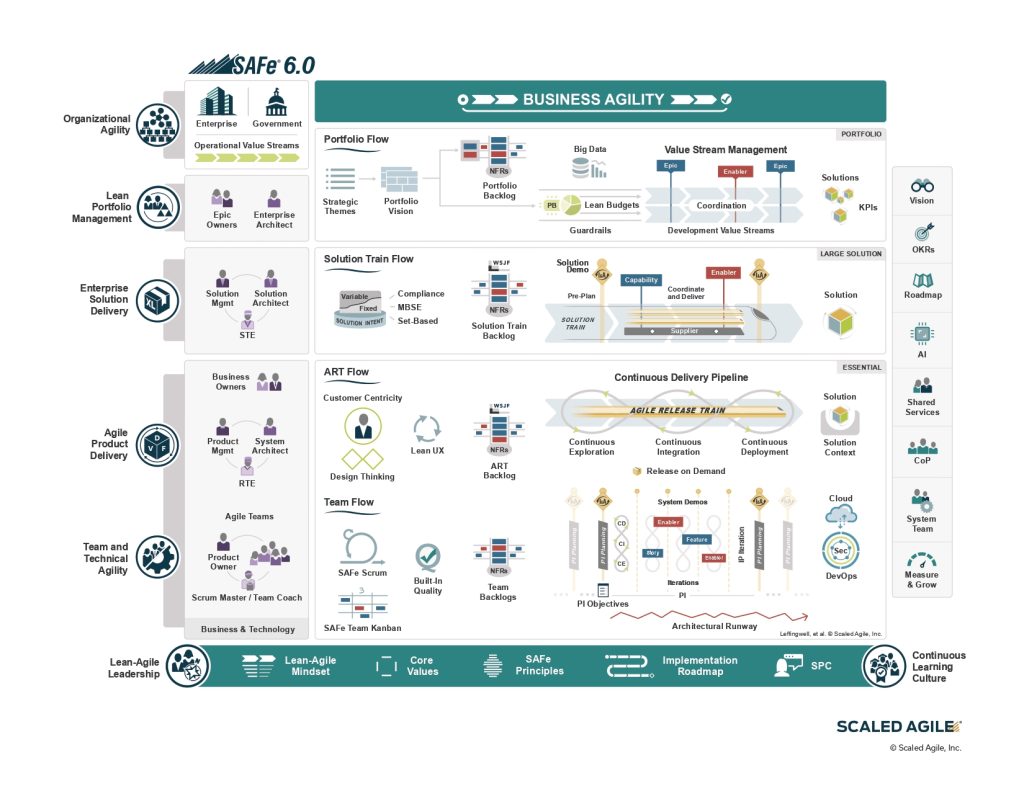
What should be observed first to help interpret the picture?
The large area is divided into three sections: Essential, Large Solution and Portfolio. The grey vertical bar on the left shows the roles. On the left, the leftmost and bottom row has the 'bubbles' indicating Competencies (e.g. Lean-Agile Leadership, Team and Technical Agility, etc.) and there is a column of small icons on the right (e.g. Business Agility is written on top), while at the bottom is a greyish green bar called the 'foundation layer', which symbolizes the foundation of how SAFe works and approaches its work.
The Essential Configuration
For example: a team of 50 people working on a product
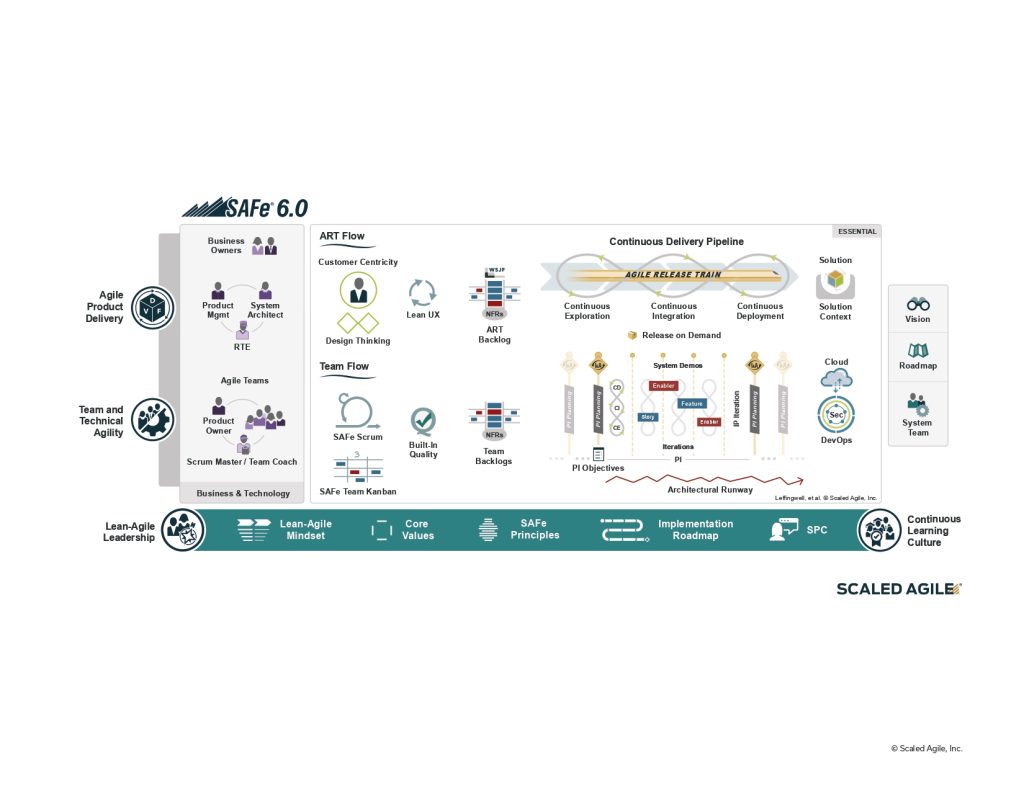
The basic configuration, the basic building block for all SAFe configurations, and the simplest first step in the implementation. It includes 4 competencies: Lean-Agile Leadership, Team and Technical Agility, and Agile Product Delivery and Continuous Learning Culture. This level is designed for teams of teams (50-125 people) who want to organise and work together following Agile operating principles. A jointly in this system means that there is a connection between them, they influence each other. We divide the 50-125 people into smaller teams, as we would in Scrum, but as you get above 50, you need coordination, and that's what SAFe focuses on: if you want to co-create a product, the teams need to know what's happening in the other team, so they can react in time and adjust their plans as needed.
The Large Solution Configuration
(E.g.: a team of 200 people working on a product)
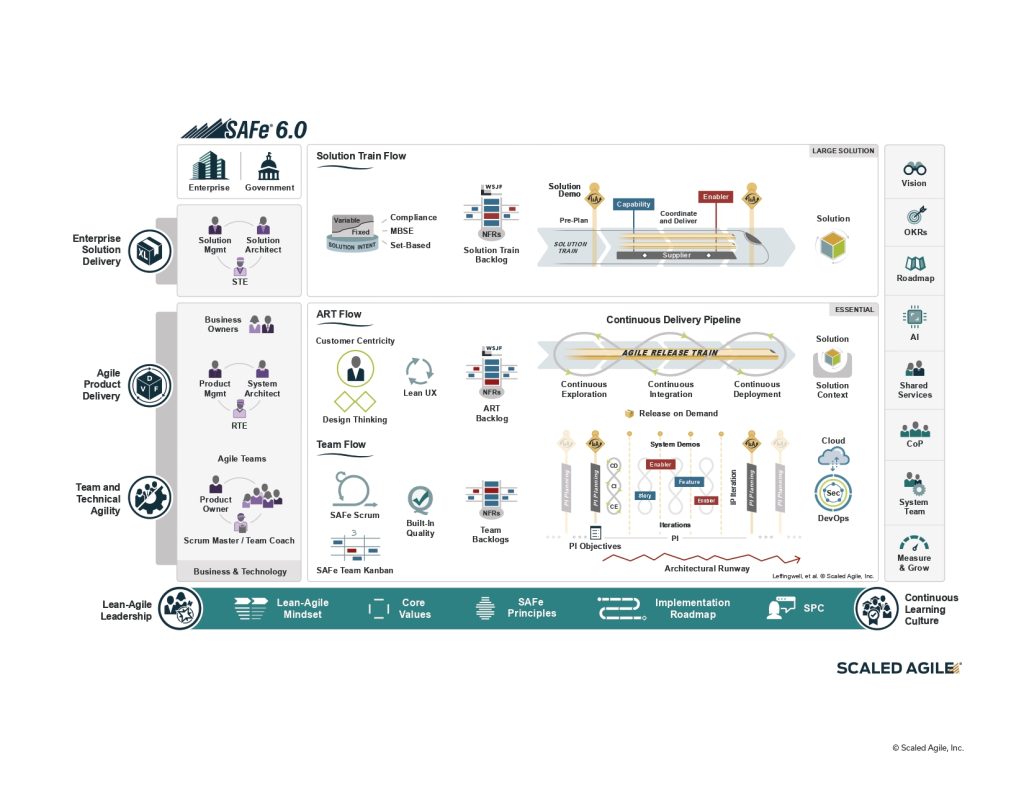
This configuration includes the Enterprise Solution Delivery competency, which enables organisations to develop large, complex solutions. These solutions operate multiple ARTs (teams of multiple teams) but do not require portfolio-level thinking. When filtering to the Large Solution layer using the tabs in the top right corner, both the Large and Essential layers are visible. New icons, new roles and a new competency will appear on this layer. The Enterprise Solution Delivery competency helps to drive a powerful value stream required to create a single complex solution or product. At the Large Solution level, we have multiple ARTs working on the same value stream, meaning we can coordinate the work of hundreds or thousands of people with this configuration.
The Portfolio Configuration
(E.g.: a team of 200 people working on several products)
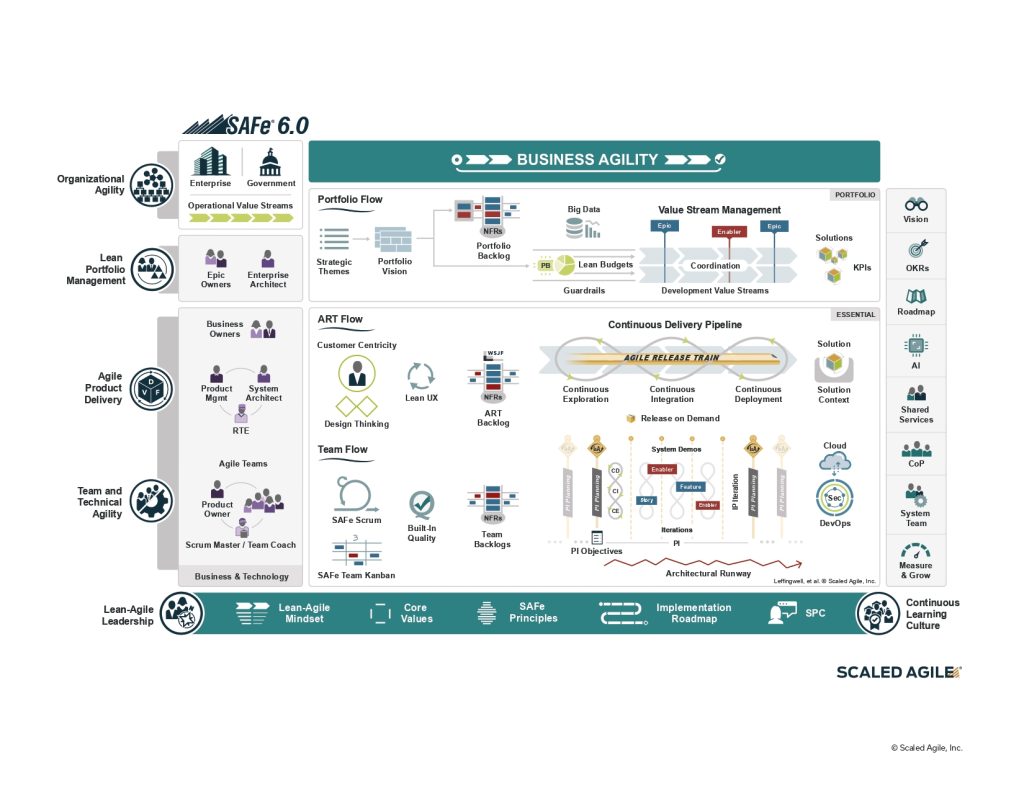
The Portfolio Configuration, which includes the Lean Portfolio Management competency that aligns portfolio implementation with corporate strategy. It is also at this level that the term Business Agility appears in the framework, i.e. the roles, tools and rules contained herein can be used to create organisational agility and the adaptive capacity of the organisation. This configuration helps the organisation to reorganise around one or more value streams.
Lean portfolio management competence is also about ensuring that money and resources are allocated to creating the most valuable things. An important difference between Large Solution and Portfolio level is that each value stream creates a separate product.
The Full Configuration

All seven competences are included. It is the most complex version of SAFe and supports companies working along large portfolios of complex solutions.
On the Scaled Agile site, each small element of the framework is clickable, with a detailed article behind it explaining the knowledge behind it.
Want to deepen your knowledge of the Scaled Agile Framework? Improve your knowledge, practical tools and get international SAFe certifications! Check out our current SAFe training courses!
The above article is the first in a series on the basic concepts of SAFe. Our aim with this series of articles is to make the knowledge about the SAFe framework available in Hungarian and to break down the complex SAFe system into understandable and learnable parts. The above article covers the background of the development of SAFe, the main concepts, the 4 key competences needed to operate the basic configuration and a brief explanation of the different configurations.

 Designabc
Designabc